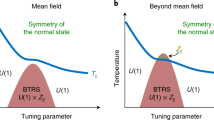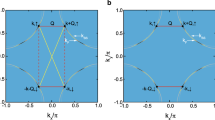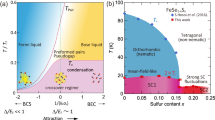Abstract
In most superconductors, the transition to the superconducting state is driven by the binding of electrons into Cooper pairs1. The condensation of these pairs into a single, phase-coherent, quantum state takes place at the same time as their formation at the transition temperature, Tc. A different scenario occurs in some disordered, amorphous, superconductors: instead of a pairing-driven transition, incoherent Cooper pairs first preform above Tc, causing the opening of a pseudogap, and then, at Tc, condense into the phase-coherent superconducting state2,3,4,5,6,7,8,9,10,11. Such a two-step scenario implies the existence of a new energy scale, Δc, driving the collective superconducting transition of the preformed pairs2,3,4,5,6. Here we unveil this energy scale by means of Andreev spectroscopy5,12 in superconducting thin films of amorphous indium oxide. We observe two Andreev conductance peaks at ±Δc that develop only below Tc and for highly disordered films on the verge of the transition to insulator. Our findings demonstrate that amorphous superconducting films provide prototypical disordered quantum systems to explore the collective superfluid transition of preformed Cooper pairs.




Similar content being viewed by others
Data availability
The data that support the plots within this paper and other findings of this study are available from the corresponding author upon reasonable request.
References
Bardeen, J., Cooper, L. N. & Schrieffer, J. R. Theory of superconductivity. Phys. Rev. 108, 1175–1204 (1957).
Ghosal, A., Randeria, M. & Trivedi, N. Role of spatial amplitude fluctuations in highly disordered s-wave superconductors. Phys. Rev. Lett. 81, 3940–3943 (1998).
Ghosal, A., Randeria, M. & Trivedi, N. Inhomogeneous pairing in highly disordered s-wave superconductors. Phys. Rev. B 65, 014501 (2001).
Feigel’man, M. V., Ioffe, L. B., Kravtsov, V. E. & Yuzbashyan, E. A. Eigenfunction fractality and pseudogap state near the superconductor–insulator transition. Phys. Rev. Lett. 98, 027001 (2007).
Feigel’man, M. V., Ioffe, L. B., Kravtsov, V. E. & Cuevas, E. Fractal superconductivity near localization threshold. Ann. Phys. 325, 1390–1478 (2010).
Bouadim, K., Loh, Y. L., Randeria, M. & Trivedi, N. Single- and two-particle energy gaps across the disorder-driven superconductor-insulator transition. Nat. Phys. 7, 884–889 (2011).
Sacépé, B. et al. Disorder-induced inhomogeneities of the superconducting state close to the superconductor–insulator transition. Phys. Rev. Lett. 101, 157006 (2008).
Sacépé, B. et al. Pseudogap in a thin film of a conventional superconductor. Nat. Commun. 1, 140 (2010).
Mondal, M. et al. Phase fluctuations in a strongly disordered s-wave NbN superconductor close to the metal–insulator transition. Phys. Rev. Lett. 106, 047001 (2011).
Sacépé, B. et al. Localization of preformed Cooper pairs in disordered superconductors. Nat. Phys. 7, 239–244 (2011).
Chand, M. et al. Phase diagram of the strongly disordered s-wave superconductor NbN close to the metal–insulator transition. Phys. Rev. B 85, 014508 (2012).
Deutscher, G. Andreev–Saint-James reflections: a probe of cuprate superconductors. Rev. Mod. Phys. 77, 109–135 (2005).
Anderson, P. W. Theory of dirty superconductors. J. Phys. Chem. Solids 11, 26–30 (1959).
Abrikosov, A. A. & Gorkov, I. P. On the theory of superconducting alloys. Sov. Phys. JETP 8, 1090–1098 (1959).
Goldman, A. M. & Marković, N. Superconductor–insulator transitions in the two dimensional limit. Phys. Today 51, 39–44 (1998).
Gantmakher, V. F. & Dolgopolov, V. T. Superconductor–insulator quantum phase transition. Phys.-Uspekhi 53, 1–49 (2010).
Sherman, D., Kopnov, G., Shahar, D. & Frydman, A. Measurement of a superconducting energy gap in a homogeneously amorphous insulator. Phys. Rev. Lett. 108, 177006 (2012).
Noat, Y. et al. Unconventional superconductivity in ultrathin superconducting NbN films studied by scanning tunneling spectroscopy. Phys. Rev. B 88, 014503 (2013).
Ganguly, R. et al. Magnetic field induced emergent inhomogeneity in a superconducting film with weak and homogeneous disorder. Phys. Rev. B 96, 054509 (2017).
Deutscher, G. Coherence and single-particle excitations in the high-temperature superconductors. Nature 397, 410–412 (1999).
Andreev, A. F. The thermal conductivity of the intermediate state in superconductors. Sov. Phys. JETP 19, 1228–1231 (1964).
Shahar, D. & Ovadyahu, Z. Superconductivity near the mobility edge. Phys. Rev. B 46, 10917–10922 (1992).
Agraït, N., Rodrigo, J. G. & Vieira, S. Transition from the tunneling regime to point contact and proximity-induced Josephson effect in lead–normal–metal nanojunctions. Phys. Rev. B 46, (R)5814–(R)5817 (1992).
Blonder, G. E., Tinkham, M. & Klapwijk, T. M. Transition from metallic to tunneling regimes in superconducting microconstrictions: excess current, charge imbalance, and supercurrent conversion. Phys. Rev. B 25, 4515–4532 (1982).
Burmistrov, I. S., Gornyi, I. V. & Mirlin, A. D. Local density of states and its mesoscopic fluctuations near the transition to a superconducting state in disordered systems. Phys. Rev. B 93, 205432 (2016).
Klapwijk, T. M., Blonder, G. E. & Tinkham, M. Explanation of subharmonic energy gap structure in superconducting contacts. Physica 109–110, 1657–1664 (1982).
Octavio, M., Tinkham, M., Blonder, G. E. & Klapwijk, T. M. Subharmonic energy-gap structure in superconducting constrictions. Phys. Rev. B 27, 6739–6746 (1983).
Sacépé, B. et al. High-field termination of a Cooper-pair insulator. Phys. Rev. B 91, 220508(R) (2015).
Acknowledgements
We thank M. Feigel’man, L. Ioffe and Y. Nazarov for fruitful discussions. This research was supported in part by the French National Agency ANR-10-BLANC-04030-POSTIT, ANR-16-CE30-0019-ELODIS2 and the H2020 ERC grant QUEST no. 637815.
Author information
Authors and Affiliations
Contributions
B.S. and J.S. prepared the samples. T.D. and C.C. performed the experiments. T.D., B.S. and C.C. carried out the analysis and interpretation of the results. B.S. wrote the manuscript with the input of all co-authors. C.C. conceived and supervised the project.
Corresponding authors
Ethics declarations
Competing interests
The authors declare no competing interests.
Additional information
Publisher’s note: Springer Nature remains neutral with regard to jurisdictional claims in published maps and institutional affiliations.
Supplementary information
Supplementary Information
Supplementary Figures 1–11; Supplementary Table 1; Supplementary References 1–6
Rights and permissions
About this article
Cite this article
Dubouchet, T., Sacépé, B., Seidemann, J. et al. Collective energy gap of preformed Cooper pairs in disordered superconductors. Nat. Phys. 15, 233–236 (2019). https://doi.org/10.1038/s41567-018-0365-8
Received:
Accepted:
Published:
Issue Date:
DOI: https://doi.org/10.1038/s41567-018-0365-8
- Springer Nature Limited
This article is cited by
-
Transmission Properties in a One-Dimensional Symmetric Ternary Nanolayered Photonic Crystal Designed with Superconductor and Silicon-Based Materials
Journal of Superconductivity and Novel Magnetism (2023)
-
Engineered disorder in CO2 photocatalysis
Nature Communications (2022)
-
Evidence for unconventional superconductivity in twisted bilayer graphene
Nature (2021)
-
Resonant Andreev reflections probed by photon-assisted tunnelling at the atomic scale
Nature Physics (2020)
-
Quantum breakdown of superconductivity in low-dimensional materials
Nature Physics (2020)





